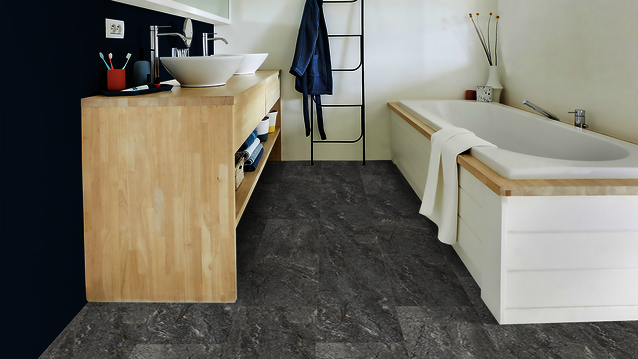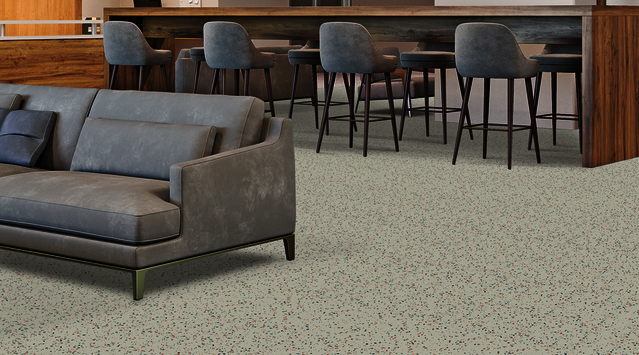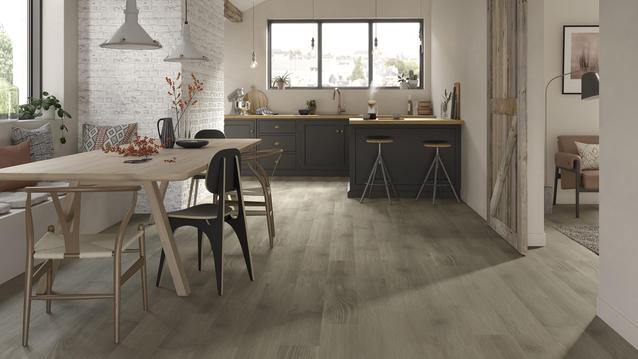
How to install vinyl flooring
How to install vinyl flooring
Vinyl is one of the easiest floors to install. However, how you install your floor will depend on the vinyl product you choose and on the manufacturer's installation instructions.
However, regardless of the type of vinyl floor you choose, you still need to undertake a few preliminary steps to ensure you install your floor properly. To get started, you need to do the following:
• In most cases, you need to remove the existing floor covering. However, there are a few exceptions. Rigid LVT, for instance, can be installed directly over tiles and most existing subfloors. Vinyl roll can be laid over linoleum coverings, but the floor must be in good condition, without any cracks, and cleaned beforehand. It’s not recommended to install vinyl roll or LVT on carpet or very flexible plastic coverings with textile or foam backing such as old vinyl floors. It’s also not recommended to install vinyl roll on tile due to the telegraphing effect where the joints of the tiling become visible on the surface of the vinyl roll. If you are installing on tiles, you need to use a levelling compound to ensure the floor is level and flat.
• Ensure the subfloor is dry, clean and flat
• Remove your vinyl floor from its packaging and keep it in the room where it is to be installed for at least 24 hours so that it can adjust to the room temperature.
How do you install LVT?
There are several ways to install LVT, however, one of the quickest and easiest ways is by using the click system.
Starfloor Click products are designed with click installation, which allows for two simple and versatile installation methods:
• Angling – This method is used for our Starfloor Click 30 collection. It allows for angle-locking installation, where planks or tiles are installed on an angle along both their short and long ends
• Push-down – This method is used with our Starfloor Click 55 and Starfloor Click Ultimate collections and involves using a rubber hammer on the short side to tap the vinyl tiles or planks down.
Thanks to click system technology, installing your LVT flooring is effortless and fast. Also, since LVT is an easy modular system, there’s no need to move all the furniture out of the room during installation. You can simply install your vinyl floor step by step by repositioning your furniture around the room as you go.
How do you install vinyl roll?
There are three main ways to install Tarkett vinyl roll. The type of installation method you use depends on the product you choose and also on the size of the room.
• Full loose lay – simply lay your vinyl floor on top of the subfloor. You then need to unroll and cut the floor to size. We recommend this method for small areas under 12m².
• Half loose lay – using double-sided duct tape around the room to secure the flooring. We recommend this method for medium areas between 12 and 25m².
• Fully glued – using a water-based spray adhesive, such as Tarkospray, Tarkett’s easy and eco-friendly solution. We recommend this method for large areas over 25m².
The main installation method for Tarkett vinyl roll is the half loose lay method, which is also the most DIY-friendly option. A simple utility knife is usually the only tool you’ll need.
What is the quickest and easiest vinyl floor to install yourself?
If you’re looking to renovate and want the best results in the quickest time possible, Tarkett offers a range of vinyl flooring options that are quick and easy to install.
Within our LVT range, the quickest and easiest vinyl floor to install yourself is the Tarkett Starfloor Click Ultimate, a new generation of Rigid LVT, which uses the i4F triple click system, one of the easiest and fastest installation system on the market. Using this system, installation is intuitive, requiring you to simply drop, lock, and click the floors into place.
Within our vinyl roll range, any floor using the full loose lay installation method is also quick and easy to install. The full loose-lay method involves simply laying your vinyl floor on top of the subfloor, without the need for tape or glue. You just need to unroll the vinyl roll and cut the floor to size! You can also choose one of vinyl products that have a textile backing, as these are designed to level off small irregularities on the subfloor.
What direction should I lay my vinyl plank flooring?
Since vinyl plank flooring was made to imitate real wood flooring, you should lay your vinyl planks in the same way you would real wood planks or boards. If the room is rectangular, lay planks parallel to the longer wall, and if the room is square, lay planks towards the main source of light. If you’re installing vinyl in a corridor, always lay the planks along the length of it.
Do you need underlay for vinyl floors?
The type of vinyl floor you choose and the type of subfloor you have will determine if you need an underlay. Some vinyl floors are designed to lay directly on top of the subfloor, while other vinyl floors have a cushioned base layer, removing the need for additional underlay.
Most vinyl flooring products don’t need an underlay; however, it is an option if you’re looking for extra cushion, noise reduction, or thermal properties.
Benefits of vinyl flooring underlay
Using an underlay offers many benefits:
• It provides sound insulation, reducing both in-room noise levels and sound transmission between floors.
• It adds cushion to the floor and locks in thermal properties, creating a softer and warmer feeling underfoot.
• It acts as a vapour barrier, which may be required, for example, on a concrete subfloor with moisture concerns.
If you are using underlay, you must ensure that your subfloor is dry, clean and flat before installing your vinyl floor.
Built-in underlay
Most Tarkett vinyl floors have a foam backing, removing the need for any additional underlay. For example, Tarkett’s Starfloor Click Ultimate range has an integrated acoustic backing with Soundblock technology, which has the capacity to absorb 19dB.
What adhesive do you use for vinyl flooring?
You don’t need adhesive to install any of the Tarkett LVT flooring options. However, if you’re using the glued installation method for your Tarkett vinyl roll flooring, we recommend using a water-based spray adhesive such as Tarkett’s easy and eco-friendly solution, Tarkospray.



